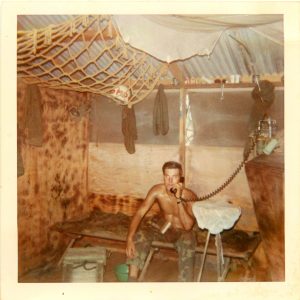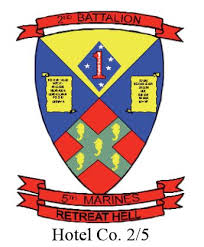 The AN/PRC-25 (AKA “Prick-25”) had a relatively short but very successful history before it was soon replaced by the incrementally improved but nearly identical AN/PRC-77. In 1967-1969 we used this radio as our main means of communicating between squads, companies, and battalion command. It was used to communicate with each other, call in artillery, air support, medivacs, helo transport, and resupply.
The AN/PRC-25 (AKA “Prick-25”) had a relatively short but very successful history before it was soon replaced by the incrementally improved but nearly identical AN/PRC-77. In 1967-1969 we used this radio as our main means of communicating between squads, companies, and battalion command. It was used to communicate with each other, call in artillery, air support, medivacs, helo transport, and resupply.
I can remember one of those exhausting days in ITR after boot camp, Las Pulgas, at Camp Pendleton, in the fall of 1968, when we recruits were in the classroom ( a very old unairconditioned Quonset hut) learning about the PRC-25 radio. I heard a staff sergeant instructor talking about this radio in that class. He said something about that radio that day, that I have always remembered. He said, “that in 1965, General Creighton Abrams called the PRC-25, the most important tactical item in Vietnam today”. “More important than the M-16 rifle, more important than the UH-1 ‘Huey’ helicopter.” That instructor got my attention, and I thought about his statement quoting a military general for many weeks to come, and then again when I got to Vietnam.
The PRC-25 radio had two antennas, a 3-foot standard antenna and a 10-foot long-range antenna that we carried in a canvas bag attached to the radio’s side. All the controls were mounted to the top and the battery was contained in a compartment on the bottom. There were two places to attach handsets and two knobs to set the frequency and a knob each for volume and squelch. The antenna is attached to the top too. There were handles at each side.  When crossing rivers, I had to hold the H-189 handset up out of reach of the water because it wasn’t waterproof. I would use the plastic bag that a new battery came in to place over my handset to keep it dry when around water. All in all, the PRC-25 weighed about 25 lbs. I always carried an extra battery for my radio weighing about 4.5 lbs. per battery.
When crossing rivers, I had to hold the H-189 handset up out of reach of the water because it wasn’t waterproof. I would use the plastic bag that a new battery came in to place over my handset to keep it dry when around water. All in all, the PRC-25 weighed about 25 lbs. I always carried an extra battery for my radio weighing about 4.5 lbs. per battery.
I was never assigned as a MOS 0621 – Radio Operator. I was a MOS 0311 – Rifleman when I left boot camp and while in Hotel 2/5 in Vietnam. After spending three weeks on Operation Taylor Common up in the jungle mountains, we had returned to a large flat valley with three mountain ranges around it, full of rice patties and its farmers known as “The Arizona Territory”. It was early February 1969. We had humped all day down the mountain and out into the flat land when we engaged an NVA battalion size force shooting at us. Three Marines from my platoon had to be medivaced along with several others from Hotel Company wounded and dead. After the battle, after the medivac helicopters were gone, we began to clean up the battlefield, picking up gear left behind from those dead and wounded bodies. I looked around and noticed three backpacks with PRC-25 radios laying on the ground.
I looked at those radios and began to think back to what that staff sergeant in ITR Training said about the PRC-25 being more powerful than the M-16 I was using. I saw the need and was willing to accept the responsibility and sieged the opportunity at that moment. I stepped up immediately and told my platoon leader that I was willing and able to carry and use one of those radios. For some odd reason, I already knew the military phonetic alphabet and didn’t have to learn it then. No one else volunteered to pick up any of those radios. My PL told me to pick out any one of them. So, I picked up the nicest newer one with the better backpack support. I wiped off the blood the best I could, threw it over my shoulders, and tightened the straps. It was a good fit. The only thing different that day was I still was a combat marine with the same responsibilities but now additionally carrying a radio, listening to the chatter and talking on it. Within two days, I had the lingo down and understood how to use it.
 I underestimated the overall weight of the gear ratio. I underestimated the ten-foot whip antenna sticking out of the back of my pack which drew unwanted attention. The three-foot antenna worked on the open flats and in rice paddies but not up in the jungle. The Viet Cong knew what it meant to take a guy out with a giant antenna sticking out of their back – you take out the radio operator and you effectively avoid dealing with air support. Additionally, it was well known that a radio operator’s place in the marching order was at the heels of the offer-in-charge – two high-priority targets in one spot. It wasn’t just the bullets that I had to watch out for. The antenna could get caught in a trip wire overhead in a tree line to set off a booby trap. I was always careful with the antenna and the handset, not to expose them when on patrols.
I underestimated the overall weight of the gear ratio. I underestimated the ten-foot whip antenna sticking out of the back of my pack which drew unwanted attention. The three-foot antenna worked on the open flats and in rice paddies but not up in the jungle. The Viet Cong knew what it meant to take a guy out with a giant antenna sticking out of their back – you take out the radio operator and you effectively avoid dealing with air support. Additionally, it was well known that a radio operator’s place in the marching order was at the heels of the offer-in-charge – two high-priority targets in one spot. It wasn’t just the bullets that I had to watch out for. The antenna could get caught in a trip wire overhead in a tree line to set off a booby trap. I was always careful with the antenna and the handset, not to expose them when on patrols.
 I had become a squad radio operator by default, then later a platoon radio operator. It was a gutsy move to have volunteered to pick up that radio. Little then, did I realize that God had a plan for me, and the PRC-25 radio (another story). From then on except for the time in late May – June 1969 for six weeks, I always had the PRC-25 radio near me or strapped on my back for the rest of my tour in Vietnam.
I had become a squad radio operator by default, then later a platoon radio operator. It was a gutsy move to have volunteered to pick up that radio. Little then, did I realize that God had a plan for me, and the PRC-25 radio (another story). From then on except for the time in late May – June 1969 for six weeks, I always had the PRC-25 radio near me or strapped on my back for the rest of my tour in Vietnam.
Picture: Me and my radio on Hill 65 August 1969.
Larry D. Tyler
1969 Vietnam Veteran

